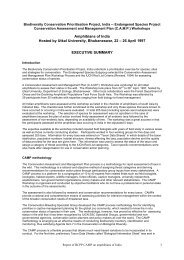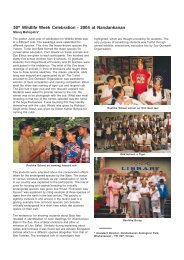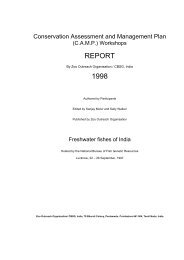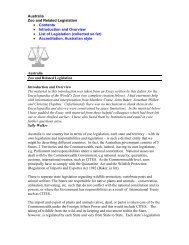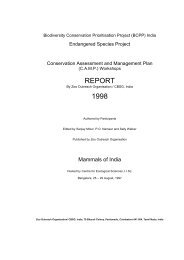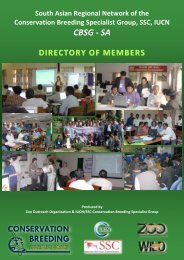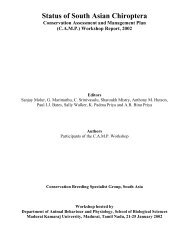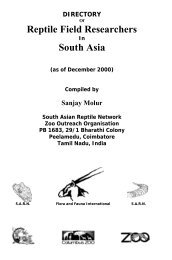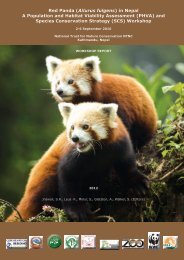Bugs R all March 2011 FINAL daniel - Zoo Outreach Organisation
Bugs R all March 2011 FINAL daniel - Zoo Outreach Organisation
Bugs R all March 2011 FINAL daniel - Zoo Outreach Organisation
- No tags were found...
Create successful ePaper yourself
Turn your PDF publications into a flip-book with our unique Google optimized e-Paper software.
Table 1. A systematic list of butterflies with their foraging behaviourSpecies Food plant AverageTime spentFlower typeFlowerpositionFlower colourObservation & BehaviourNymphalidae Mickenla cordata 3-5 Sec Inflorescence Axillary Pale white Nectar feeding along with pollen(Krishamegh Kunte, 2000). No specificmethodology was used. The time spent bythe butterflies on flowers of compositefamily is more. Very active but weak on thewing, fliesErgois merione Riccnus communis 4-6 Sec Inflorescence Axillary Pale white Gracefully as of sailing through the airamong dense vegetation, rest on top canopy,Sida rhobifolia 1-2 Sec Solitary Axillary Pale yellowprefer shady places, wings are movedslowly sideways while rest.Tridax procumbans 5-6 Sec Racemose Terminal Bright yellowNeptis hylas - 10 - 15 min the sameplacePrecis atlitesAgeratum conizoidsLantana camara3-4 Sec30-33 SecPantoporia perius - 12 - 15 min the sameplace- - - Basking in sun, also attracted to humansweat, Rarely visit flowers, flies by flippingtheir wings repeatedly and then glidingrespectively.RacemoseInflorescencePrecis almana Tridax procumbans 9-10 Sec RacemoseInflorescenceAxillaryAxillaryLilac PinkNectar feeding along with pollen.- - - Basking in the sun, flies close to the groundwithout even settling except rarely ondamp patches.Terminal Bright yellowNectar feeding along with pollen, whilefeeding butterflies rotate around the flowerfor changing the position of the proboscis.Precis iphita iphita - 10 - 15 - - - Usu<strong>all</strong>y seen in damp patches and shadyplaces & were found sucking juice fromrotting jack fruit.DanaidaeDanais chrysippus Sida spp 4-6 Sec Solitary Axillary Pale yellow Nectar feeding, usu<strong>all</strong>y fly in an undulatingfashion and remains on wing for few secondsAcraeidaeAerva lanata 9-10 Sec Inflorescence Axillary Pale whiteTelchinia violae Sida spp 3-5 Sec Solitary Axillary Red Nectar feeding, flies slowly, close toground, flittering their wings unsteadily,often found basking in early morning sun.PieridaeCatospsilia crocale Mickenla spp 9-10 Sec Inflorescence Axillary Pale white Nectar feeding along with pollen, flies veryfast, covering long distance, high above theground in straight, powerful long up anddown curved flight.Catopsilia pyranthe Ageratum conizoids 5-10 Sec Inflorescence Axillary Lilac Nectar feedingLeptosia nina ninaSida spp 4-6 Sec Pale yellowTridax sppSida spp4-5 Sec10-11 SecRacemoseInflorescenceSolitaryTerminalAxillaryPalewhitePale yellowNectar feeding along with pollen, slow andirregular flight, flies very close to theground with rhythmic slow closing andopening of the wings, rest on lower side ofthe leaf with their wings closed.Terias hecabe Sida spp 5-7 Sec Solitary Axillary Pale yellow Nectar feeding, mud puddlers.PapilionidaeLeucas 3-4 Sec Inflorescence Axillary WhiteZetides agamemnon Lantana spp 4- 5 sec Inflorescence Axillary Pink Nectar feeding.Papilio polytespolytesPentas 5-6 sec DischasiatchymeAxillary Dark lilac Nectar feedingTros aristolochiae Lantana spp 4-5 sec Inflorescence Axillary Pink Nectar feeding<strong>Bugs</strong> R A! No. 17 <strong>March</strong> <strong>2011</strong> 4



